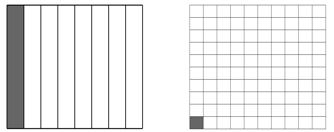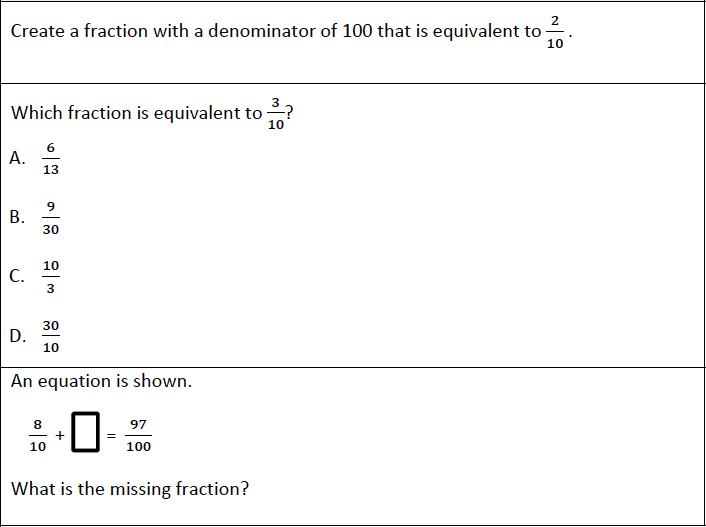Express a fraction with denominator 10 as an equivalent fraction with denominator 100, and use this technique to add two fractions with respective denominators 10 and 100. For example, express 3/10 as 30/100, and add 3/10 + 4/100 = 34/100.
[divider] [/divider]Students are able to…
- Convert tenths to hundredths and when applicable hundredths to tenths using models and pictures.
- Find patterns and make generalizations about equivalent fractions that are tenths and hundredths.
- Add and subtract tenths with hundredths using models, pictures, words and numbers to explain their thinking.
[divider] [/divider]Students are able to…because teachers…
- Provide opportunities for students to find equivalent fractions for tenths and hundredths.
- Provide activities and facilitate discussion on finding equivalent fractions of tenths and hundredths using models, including base-then blocks and hundreds grids, which later can be connected to students’ work with decimals.
- Provide opportunities for students to add and subtract tenths and hundredths using models, pictures, words, and numbers.
[divider] [/divider]Questions to ask students:
- Is 1/10 equivalent to 1/100? Use a model to prove your answer.
- Sample answer that indicates understanding: No, 1/10 is greater than 1/100. (model shown below)
- How do 1/10 and 10/100 compare?
- Sample answer that indicates understanding: 1/10 is equivalent to 10/100 because if I shade in 1/10 of a whole and 10/100 of a whole they cover the same amount of space.
- What if you combined the 1/10 and 1/100 what would be the new value?
- Sample answer that indicates understanding: Student demonstrates the understanding that 1/10 must be converted to hundredths then added. (model shown below)
- Sample answer that indicates an incomplete understanding or a misconception: Student does not convert tenths to hundredths, adds the values and find a sum 2/100 or 2/10.
[divider] [/divider]FSA Notes
Cognitive Complexity Level: 1: Recall
Achievement Level Descriptors:
2-expresses a fraction with denominator 10 as an equivalent fraction with denominator 100 by using a model
3-adds two fractions with respective denominators 10 and 100 by first finding equivalent fractions with like denominators
4-solves missing addend problems with respective denominators 10 and 100 by first finding equivalent fractions with like denominators
5-[intentionally left blank]
Assessment Limits:
Denominators must be either 10 or 100.
Decimal notation may not be assessed at this standard.
[divider] [/divider]Additional Resources:
Additional in depth content knowledge
Video: Visually converting tenths and hundredths
Add tenths and hundredths by creating equivalent fractions
[divider] [/divider]Sample Formative Assessment Tasks:
Resources/Tasks to Help Your Child at Home:
Using the attached decimal grid paper (https://goo.gl/raSmYx), have your child model addition problems with denominators of 10 and 100.
Example:
- Model 5/10 + 20/100 = 70/100
- Model 5/10 + ? = 70/100
Khan Academy: Visually Converting Tenths and Hundredths https://goo.gl/Nqeg5j
Khan Academy: Adding Fractions https://goo.gl/fHjpNm



